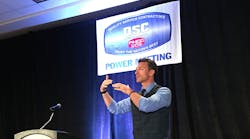MILWAUKEE — For too many contractors, profit is something they take out of the business when they sell it. It should be one of the first things that contractors get, Mike Michalowicz told members of Quality Service Contractors meeting here.
Michalowicz is a serial entrepreneur, speaker and author of a host of business books, including Profit First: Transform Your Business from a Cash-Eating Monster to a Money-Making Machine.
Michalowicz told the contractors to challenge the axiom that profit is what’s left over on the bottom line. According to a study by the Small Business Administration, of companies with revenues of $25 million or less, 83 percent are barely scraping by month by month with little cash reserve, he said.
By age 35, Michalowicz had founded and sold two multi-million dollar companies. Then, thinking that he knew everything, he became an angel investor and went broke in 2008. He started over again, driven to find better ways to grow healthy, strong companies. Oddly enough, he found inspiration watching an infomercial by a fitness instructor who said that fitness is not an event — it has to be a habit, something one does all the time. He realized that profit must be realized the same way, every week with every bank deposit. Michalowicz created the “Profit First Formula.” He is now running his third million-dollar venture.
Profit has to be taken out of every bank deposit, he said. An impediment for most contractors is that they have a single checking account into which all of the revenue is deposited and from which all of the bills are paid. A contractor should have four.
For all of the sacrifice, the owner should be paid first or else he will come to resent his business.
The profit account is the reward for the equity owners of a business. Contracting business owners take extraordinary risk, so they need to be rewarded.
The second account is the owner’s compensation account.
“Who’s your best employee?”, he asked the QSC members. It was a trick question. The owner, the founder of the firm is the best employee. For all of the sacrifice, the owner should be paid first or else he will come to resent his business.
The third account is the tax account. When it comes time to file taxes, whether that’s quarterly or yearly, the business must pay the taxes. It can’t come from the owner’s money.
The final checking account pays for operating expenses.
Michalowicz suggested that contractors deposit 10 percent into their profit account, 10 percent to owner’s compensation, 15 percent to taxes and 65 percent to operating expenses.
To owners who say it can’t be done, Michalowicz insists that of course it can be done. Think about how things worked when you were starting out. You didn’t have any resources then, but you made it work.
This is actually based on economic theory from Cyril Northcote Parkinson, the economist best known for stating that work expands to fill the time allotted. Parkinson noted that spending expands to consume the available money. He also posited that supply dictates demand, not the other way around. If there’s a large supply of something, consumers will gobble it up.
If a profit-first business limits the amount of money available to pay operating expenses, Michalowicz maintained, it becomes more innovative and extracts maximum value out of the money it has.
People being people, they will revert to old habits and try to pay operating expenses out of the profit account, which defeats the purpose. Michalowicz told the contractors to hide the money. The profit account and the tax account must be in a different bank, preferably one that’s inconvenient to get to. No online banking and no ATM card.
He suggested that contractors pay their bills on the 10th of the month and on the 25th. All the vendors get their money prior to the due date on either the 15th or the 30th. A contractor can watch the deposits in the operating expense account grow and then go to zero as the bills are paid, grow and go to zero. Cash flow become a rhythm and the contractor can soon see what’s normal cash flow and what’s not.
All this time, money is accumulating in the profit account. Each quarter, the contractor should pay himself 50 percent of the money in the profit account, Michalowicz said. Any contractor who doesn’t know what to do with the quarterly influx of cash need only ask his spouse. The profit payments become addicting and can change a contractor’s thinking about how he operates his business. He determines to service only profitable clients and pursue high-profit, high-growth activity.









